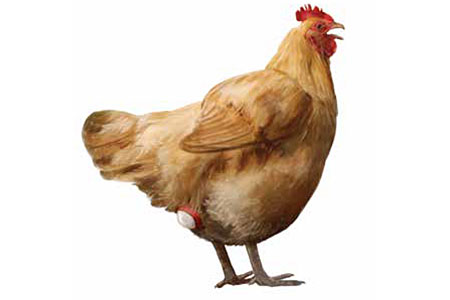
One of the most common health conditions of laying hens is vent prolapse. Other names for the condition are blowout, cloacal prolapse, and prolapsed oviduct.
What Is Prolapse?
Prolapse is actually the natural process by which a hen lays eggs. When a hen is ready to lay an egg, her vagina tightly grips the completed egg. To deposit the egg, the tissue then pushes the egg through the cloaca by prolapsing, or turning itself inside out.
The tissue then typically withdraws back inside the hen. A serious health issue occurs, though, if the pink tissue remains protruding outside the vent.
In that case, the protruding tissue attracts other chickens to start picking. If the situation continues, eventually the flock will pull out the victim’s innards. The hen will then die from hemorrhage and shock, a condition known as pickout.
Causes of Vent Prolapse
The cause of vent prolapse often relates to the hen’s age and management. Any condition that weakens vaginal muscles, including infection, can result in vent prolapse.
A pullet may prolapse if she starts laying before her body is fully mature. Vent prolapse is especially likely if the pullet is laying big double yolk eggs. The appearance of eggs with two yolks is often a sign that the pullet’s production cycle is not yet synchronized.
Calcium deficiency can result in vent prolapse. Commercially formulated rations may claim to include adequate calcium, but in fact they may not provide enough for some laying hens. Access to a calcium supplement is therefore essential, offered free choice, separately from lay ration. Supplements include ground aragonite, crushed oyster shells, or chipped limestone.
Vent prolapse can occur in an older hen that’s overweight. Some hens gradually accumulate fat as they age. That’s especially true of cold hardy breeds that have a natural tendency to put on extra fat for warmth. Obesity is also likely when chickens are fed more energy-rich feed than they need, often in the form of too many treats.
To determine if a chicken is overweight, check the area below her vent. If it bulges and looks dimply, the hen is too fat.
Treating Vent Prolapse
If you catch a vent prolapse in time you can often reverse it. Clean the protruding tissue, apply an anti-inflammatory cream (such as hydrocortisone), and gently push the tissue back inside the hen.
If the tissue comes back out, repeat the treatment. In an extreme case, an avian veterinarian can stitch the tissue in place.
To prevent picking and give the hen time to heal, isolate the patient until she improves. Be sure to provide feed and clean water.
Discouraging the hen from laying will help her heal more quickly. Arrange her recovery unit in a place where she gets no more than 8 hours per day of light. For instance, you might let her outdoors for 8 hours. Then bring her into a darkened area for the rest of the day.
Be aware, though, that once a hen experiences a vent prolapse, she may do so again in the future. Or, she may not.
And that’s today’s news from the Cackle Coop.
Gail Damerow has written several books about keeping poultry, many of them available from the Cackle Bookstore. Illustration from The Chicken Health Handbook.

